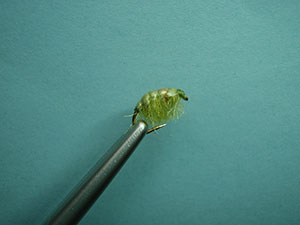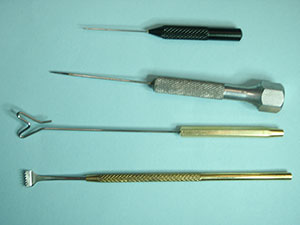Royal Coachman Bucktail
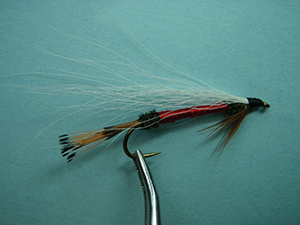
Dave Hughes
Edited by Carl Wuebben
The golden age of streamers lasted two or three decades, ending in the 1960s. But these beautiful flies represent things that trout still eat, and they still catch trout. If you’d like to be armed to fish the full array of trout tactics, in order to take fish in all sorts of conditions, a few of these traditional dressings should be kept ready in your basic fly boxes. When you find big trout pursuing baitfish, you can coax them to these minnow like imitations and to little else. Traditional streamers also make excellent searching patterns. In early spring when the water is still high, unclear and cold, then again in fall, when the water is low and clear but cooling, trout are interested in feeding but don’t find much available in the way of natural insects. A streamer fished slow and near the bottom will entice them into a take if you place it where they can see it. Streamers are usually thought of as big flies, sizes 4 and 6; but I recommend that you tie them in sizes 8 and 10. You might be surprised at the results these smaller streamers bring.
PATTERN
HOOK – 6X long, TMC 300 sizes 6-8-10-12
THREAD – Black 3/0 (210 denier) or 6/0 (140 denier)
TAIL – Golden pheasant tippets
BODY – Peacock herl, red floss, peacock herl
HACKLE – Brown
WING – White bucktail
HOW TO TIE
- Debarb hook – mount in the vise – grab about eight fibers from a golden pheasant tippet then start your thread just in front of bend of the hook and then tie in the pheasant tippet (about ½ the size of the hook shank).
- Tie in about 2 or 3 strands of peacock herl at the back of the shank just before the bend of the hook. To reinforce the peacock herl, make a rope with it on the thread; twist the peacock clockwise around the thread, just about 3 or 4 turns should do. You can put more of if needed. Now wrap the rope forward about 3 or 4 turns or ¼ of the hook shank length; now tie down and clip of the tag end.
- Tie in some red floss up against the peacock and wrap it forward with close wraps to just a little past the half way mark on the hook shank, then tie off and clip the tie end off.
- Tie in some more peacock herl using the herl rope again (3 or 4 strands). Wrap forward again but stop about 4 or 5 eyelet space from the eye and tie off and cut the tag ends off.
- Find a hackle feather with the fibers about a gap and a half to two gaps long. Then you can do one of two different ways to tie on:
- Strip off a bunch of fibers from the stem of the feather and using the pinch knot/ soft loop (loop pinched between your thumb and index finger) tie it on the bottom of the shank right in front of the peacock herl but on the bottom of the hook shank, keeping some fibers out to the side also. Tie down or clip tag ends off.
- Using the whole feather, strip out the fuzz and tie it on by the butt and on the shank up against the front peacock with the concave side toward the shank, so the fibers will sweep back. Wrap forward 3-4 wraps then tie off and clip tag ends off. With a pair of sharp pointed scissors, clip off the sides and top hackle fibers as close to the stem as possible.
- Now grab a small bunch of white bucktail and comb out the under fur and tie it in just in front of the peacock that’s in the front hook area extending it over the top of the fly to just about even or just past the end of the tail.
- Make a nice bullet head (tapered thread, small in front, larger to the rear). Whip finish and apply some head cement.
TIE UP A DOZEN OR TWO – AND GO FISHING*** But remember to practice C.P.R. (CATCH – PICTURE – RELEASE).

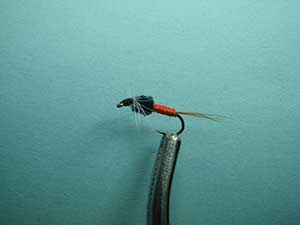
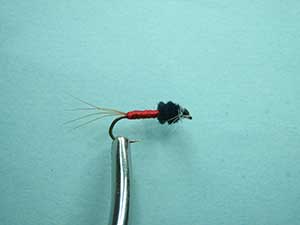
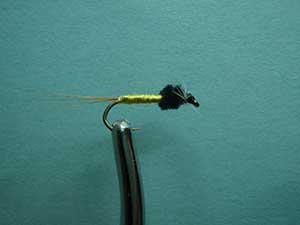
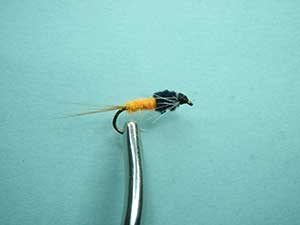
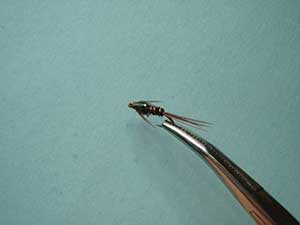
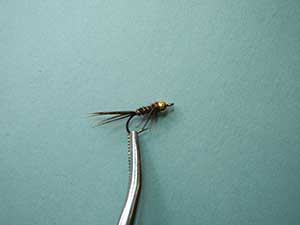
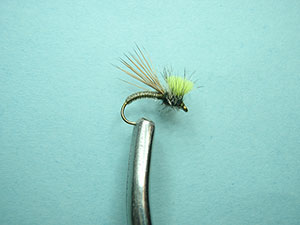
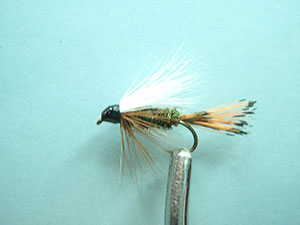 BUZ BUSZEK Translated by CARL WUEBBEN
BUZ BUSZEK Translated by CARL WUEBBEN